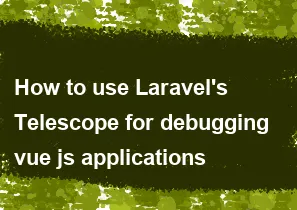How to use Laravel's Telescope for debugging vue js applications

Laravel Telescope is a powerful debugging and introspection tool for Laravel applications. While it is primarily designed for debugging server-side code, it can also be used to inspect and debug Vue.js components in your Laravel application.
Here are the steps to use Laravel Telescope for debugging Vue.js applications:
Install Laravel Telescope: Make sure you have Laravel Telescope installed in your Laravel project. You can install it using Composer:
bashcomposer require laravel/telescopeAfter installation, run the Telescope installation command:
bashphp artisan telescope:installAnd migrate the database:
bashphp artisan migrateMake sure to enable Telescope in your
config/app.phpfile by uncommenting the service provider.Publish Telescope Assets: Publish Telescope assets, including the configuration file and assets like JavaScript and CSS files:
bashphp artisan telescope:publishConfigure Telescope for Vue.js: Telescope comes with a configuration file (
config/telescope.php). Open this file and make sure theenabledoption is set totrue. Also, check the configuration options related to the Telescope assets.Instrument Vue.js Components: Laravel Telescope can capture events and requests. To debug Vue.js components, you can use the
broadcastmethod to send events to the Laravel Echo server, which Telescope can capture. For example, in your Vue component:javascriptmethods: { someMethod() { // Your logic here Echo.channel('telescope') .whisper('telescope.broadcast', { name: 'SomeEvent', data: { /* your data here */ } }); } }View Telescope Dashboard: Start your Laravel development server:
bashphp artisan serveOpen the Telescope dashboard in your browser (usually at
http://localhost:8000/telescope). Here, you can navigate to the "Watchers" section to see the events and requests captured by Telescope, including the ones sent from your Vue.js components.By inspecting these events, you can gain insights into the state and behavior of your Vue.js components during runtime.
Remember that this method may not be as seamless as using dedicated Vue.js debugging tools, but it provides a way to integrate Vue.js debugging into the Laravel Telescope environment. Additionally, consider using browser developer tools and Vue Devtools for more comprehensive client-side debugging.
-
Popular Post
- How to optimize for Google's About This Result feature for local businesses
- How to implement multi-language support in an Express.js application
- How to handle and optimize for changes in mobile search behavior
- How to handle CORS in a Node.js application
- How to use Vue.js with a UI framework (e.g., Vuetify, Element UI)
- How to configure Laravel Telescope for monitoring and profiling API requests
- How to create a command-line tool using the Commander.js library in Node.js
- How to implement code splitting in a React.js application
- How to use the AWS SDK for Node.js to interact with various AWS services
- How to use the Node.js Stream API for efficient data processing
- How to implement a cookie parser middleware in Node.js
- How to implement WebSockets for real-time communication in React
-
Latest Post
- How to implement a dynamic form with dynamic field styling based on user input in Next.js
- How to create a custom hook for handling user interactions with the browser's device motion in Next.js
- How to create a custom hook for handling user interactions with the browser's battery status in Next.js
- How to implement a dynamic form with dynamic field visibility based on user input in Next.js
- How to implement a dynamic form with real-time collaboration features in Next.js
- How to create a custom hook for handling user interactions with the browser's media devices in Next.js
- How to use the useSWRInfinite hook for paginating data with a custom loading indicator in Next.js
- How to create a custom hook for handling user interactions with the browser's network status in Next.js
- How to create a custom hook for handling user interactions with the browser's location in Next.js
- How to implement a dynamic form with multi-language support in Next.js
- How to create a custom hook for handling user interactions with the browser's ambient light sensor in Next.js
- How to use the useHover hook for creating interactive image zoom effects in Next.js